Enhancement of Xanthate Adsorption on Cerussite Surfaces by Pb(II) Activation and Its Effect on Floatability
Abstract
1. Introduction
2. Experimental
2.1. Materials
2.2. Reagents
2.3. Micro-Flotation Tests
2.4. ToF-SIMS Analysis
2.5. Adsorption Experiments
2.6. Zeta-Potential Measurements
2.7. XPS Analysis
3. Results and Discussion
3.1. Micro-Flotation Results
3.2. ToF-SIMS Analysis
3.3. Adsorption Experiments
3.4. Influence of Pb2+ on the Zeta Potential of Cerussite
3.5. XPS Analysis
4. Conclusions
Author Contributions
Funding
Institutional Review Board Statement
Informed Consent Statement
Data Availability Statement
Conflicts of Interest
Sample Availability
References
- Tao, M.; Zhang, X.; Wang, S.; Cao, W.; Jiang, Y. Life cycle assessment on lead–zinc ore mining and beneficiation in China. J. Clean. Prod. 2019, 237, 117833. [Google Scholar] [CrossRef]
- Wei, Q.; Dong, L.; Qin, W.; Jiao, F.; Qi, Z.; Feng, C.; Sun, D.; Wang, L.; Xiao, S. Efficient flotation recovery of lead and zinc from refractory lead-zinc ores under low alkaline conditions. Geochemistry 2021, 81, 125769. [Google Scholar] [CrossRef]
- Liu, C.; Zhang, W.; Song, S.; Li, H.; Jiao, X. A novel insight of the effect of sodium chloride on the sulfidization flotation of cerussite. Powder Technol. 2018, 344, 103–107. [Google Scholar] [CrossRef]
- Öztürk, Y.; Bıçak, Ö.; Özdemir, E.; Ekmekçi, Z. Mitigation negative effects of thiosulfate on flotation performance of a Cu-Pb-Zn sulfide ore. Miner. Eng. 2018, 122, 142–147. [Google Scholar] [CrossRef]
- Aikawa, K.; Ito, M.; Segawa, T.; Jeon, S.; Park, I.; Tabelin, C.B.; Hiroyoshi, N. Depression of lead-activated sphalerite by pyrite via galvanic interactions: Implications to the selective flotation of complex sulfide ores. Miner. Eng. 2020, 152, 106367. [Google Scholar] [CrossRef]
- Liu, R.; Liu, D.; Li, J.; Liu, S.; Liu, Z.; Gao, L.; Jia, X.; Ao, S. Improved understanding of the sulfidization mecha-nism in cerussite flotation: An XPS, ToF-SIMS and FESEM investigation, Colloid. Surface. A-Physicochem. Eng. Asp. 2020, 595, 124508. [Google Scholar] [CrossRef]
- Onal, G.; Bulut, G.; Gul, A.; Kangal, O.; Perek, K.; Arslan, F. Flotation of Aladag oxide lead–zinc ores. Miner. Eng. 2005, 18, 279–282. [Google Scholar] [CrossRef]
- Feng, Q.; Wen, S.; Zhao, W.; Deng, J.; Xian, Y. Adsorption of sulfide ions on cerussite surfaces and implications for flotation. Appl. Surf. Sci. 2016, 360, 365–372. [Google Scholar] [CrossRef]
- Garbassi, F.; Marabini, A.M. Spectroscopic investigation of sulphidation of zinc and lead carbonates. J. Chem. Soc. Faraday Trans. 1: Phys. Chem. Condens. Phases 1986, 82, 2043–2055. [Google Scholar] [CrossRef]
- Herrera-Urbina, R.; Sotillo, F.; Fuerstenau, D. Amyl xanthate uptake by natural and sulfide-treated cerussite and galena. Int. J. Miner. Process. 1998, 55, 113–128. [Google Scholar] [CrossRef]
- Feng, Q.; Wen, S.; Zhao, W.; Wang, Y.; Cui, C. Contribution of chloride ions to the sulfidization flotation of cerussite. Miner. Eng. 2015, 83, 128–135. [Google Scholar] [CrossRef]
- Zhang, Q.; Wen, S.; Feng, Q. Effect of CuSO4 on sulfidized cerussite surface properties and its response to the flotation behavior. Appl. Surf. Sci. 2022, 589, 152956. [Google Scholar] [CrossRef]
- Zhang, Q.; Wen, S.; Feng, Q.; Liu, Y. Activation mechanism of lead ions in the flotation of sulfidized azurite with xan-thate as collector. Miner. Eng. 2021, 163, 106809. [Google Scholar] [CrossRef]
- Feng, Q.C.; Yang, W.H.; Wen, S.M.; Wang, H.; Zhao, W.J.; Han, G. Flotation of copper oxide minerals: A review. Int. J. Min. Sci. Technol. 2022, 32, 1351–1364. [Google Scholar] [CrossRef]
- Zhang, S.; Wen, S.; Xian, Y.; Zhao, L.; Feng, Q.; Bai, S.; Han, G.; Lang, J. Lead ion modification and its enhancement for xanthate adsorption on smithsonite surface. Appl. Surf. Sci. 2019, 498, 143801. [Google Scholar] [CrossRef]
- Fuerstenau, M.; Olivas, S.; Herrera-Urbina, R.; Han, K. The surface characteristics and flotation behavior of anglesite and cerussite. Int. J. Miner. Process. 1987, 20, 73–85. [Google Scholar] [CrossRef]
- Marabini, A.; Cozza, C. A new technique for determining mineral—Reagent chemical interaction products by transmission IR spectroscopy: Cerussite—Xanthate system. Colloids Surfaces 1988, 33, 35–41. [Google Scholar] [CrossRef]
- Feng, Q.C.; Wang, M.L.; Zhang, G.; Zhao, W.J.; Han, G. Enhanced adsorption of sulfide and xanthate on smithsonite surfaces by lead activation and implications for flotation intensification. Sep. Purif. Technol. 2023, 307, 122772. [Google Scholar] [CrossRef]
- Herrera-Urbina, R.; Sotillo, F.; Fuerstenau, D. Effect of sodium sulfide additions on the pulp potential and amyl xanthate flotation of cerussite and galena. Int. J. Miner. Process. 1999, 55, 157–170. [Google Scholar] [CrossRef]
- Lai, H.; Liu, Q.; Deng, J.; Wen, S.; Liu, Z. Surface chemistry study of Cu-Pb sulfide ore using ToF-SIMS and multivariate analysis. Appl. Surf. Sci. 2020, 518, 146270. [Google Scholar] [CrossRef]
- Yang, B.; Sun, H.; Wang, D.; Yin, W.; Cao, S.; Wang, Y.; Zhu, Z.; Jiang, K.; Yao, J. Selective adsorption of a new de-pressant Na2ATP on dolomite: Implications for effective separation of magnesite from dolomite via froth flotation. Sep. Purif. Technol. 2020, 250, 117278. [Google Scholar] [CrossRef]
- Fuerstenau, D. Pradip Zeta potentials in the flotation of oxide and silicate minerals. Adv. Colloid Interface Sci. 2005, 114–115, 9–26. [Google Scholar] [CrossRef] [PubMed]
- Zouboulis, A.; Avranas, A. Treatment of oil-in-water emulsions by coagulation and dissolved-air flotation. Colloids Surf. A Physicochem. Eng. Asp. 2000, 172, 153–161. [Google Scholar] [CrossRef]
- Peng, Y.; Wang, B.; Gerson, A. The effect of electrochemical potential on the activation of pyrite by copper and lead ions during grinding. Int. J. Miner. Process. 2012, 102–103, 141–149. [Google Scholar] [CrossRef]
- Popov, S.; Vučinić, D. Kinetics of ethylxanthate adsorption on cerussite in alkaline media in presence or absence of dis-solved lead ions. Int. J. Miner. Process. 1994, 41, 115–128. [Google Scholar] [CrossRef]
- Wang, C.; Huang, X.; Lim, M.K.; Tseng, M.-L.; Ghadimi, P. Mapping the structural evolution in the global scrap copper trade network. J. Clean. Prod. 2020, 275, 122934. [Google Scholar] [CrossRef]
- Wang, X.; Liu, W.; Jiao, F.; Qin, W.; Yang, C. New insights into the mechanism of selective flotation of copper and copper-tin alloy. Sep. Purif. Technol. 2020, 253, 117497. [Google Scholar] [CrossRef]
- Zhao, W.; Liu, D.; Wen, S.; Feng, Q. Surface modification of hemimorphite with lead ions and its effect on flotation and oleate adsorption. Appl. Surf. Sci. 2019, 483, 849–858. [Google Scholar] [CrossRef]
- Mann, A.; Deutscher, R. Solution geochemistry of lead and zinc in water containing carbonate, sulphate and chloride ions. Chem. Geol. 1980, 29, 293–311. [Google Scholar] [CrossRef]
- Powell, K.; Brown, P.; Byrne, R.; Gajda, T.; Hefter, G.; Leuz, A.; Sjoberg, S.; Wanner, H. Chemical speciation of environ-mentally significant metals with inorganic ligands. Part 3: The Pb2+, OH−, Cl−, CO32–, SO42–, and PO43– systems (IUPAC Tech-nical Report). Pure Appl. Chem. 2009, 81, 2425–2476. [Google Scholar] [CrossRef]
- Zhao, W.; Liu, D.; Feng, Q. Enhancement of salicylhydroxamic acid adsorption by Pb(II) modified hemimorphite sur-faces and its effect on floatability. Miner. Eng. 2020, 152, 106373. [Google Scholar] [CrossRef]
- Feng, Q.; Zhao, W.; Wen, S.; Cao, Q. Activation mechanism of lead ions in cassiterite flotation with salicylhydroxamic acid as collector. Sep. Purif. Technol. 2017, 178, 193–199. [Google Scholar] [CrossRef]
- Zhang, Q.; Wen, S.; Feng, Q.; Liu, J. Surface modification of azurite with lead ions and its effects on the adsorption of sulfide ions and xanthate species. Appl. Surf. Sci. 2020, 543, 148795. [Google Scholar] [CrossRef]
- Zhang, Q.; Wen, S.M.; Feng, Q.C.; Wang, H. Enhanced sulfidization of azurite surfaces by ammonium phosphate and its effect on flotation. Int. J. Miner. Metall. Mater. 2022, 29, 1150–1160. [Google Scholar] [CrossRef]
- Mu, Y.; Li, L.; Peng, Y. Surface properties of fractured and polished pyrite in relation to flotation. Miner. Eng. 2017, 101, 10–19. [Google Scholar] [CrossRef]
- Cao, Z.; Chen, X.; Peng, Y. The role of sodium sulfide in the flotation of pyrite depressed in chalcopyrite flotation. Miner. Eng. 2018, 119, 93–98. [Google Scholar] [CrossRef]
- Ejtemaei, M.; Nguyen, A.V. Characterisation of sphalerite and pyrite surfaces activated by copper sulphate. Miner. Eng. 2016, 100, 223–232. [Google Scholar] [CrossRef]
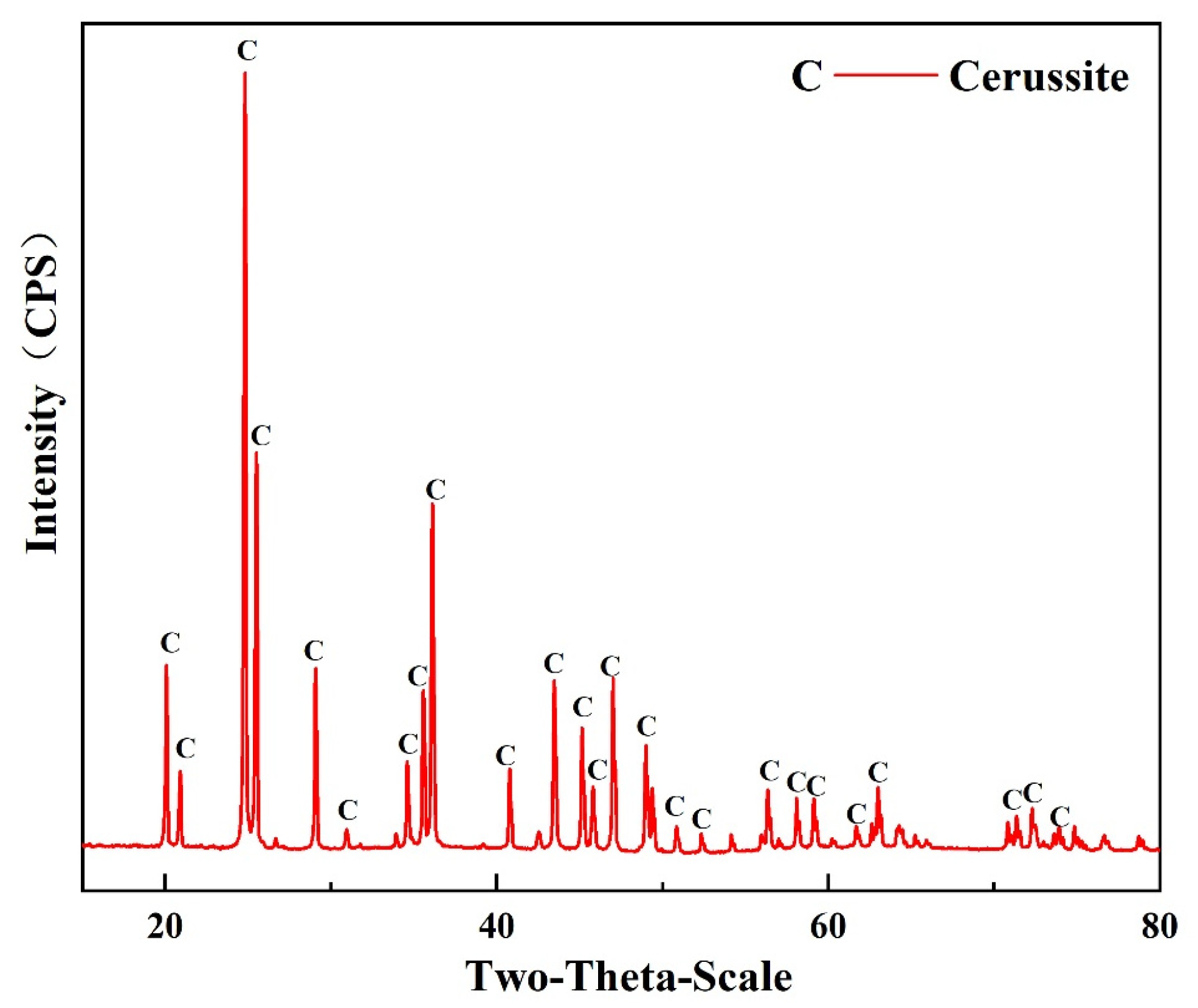
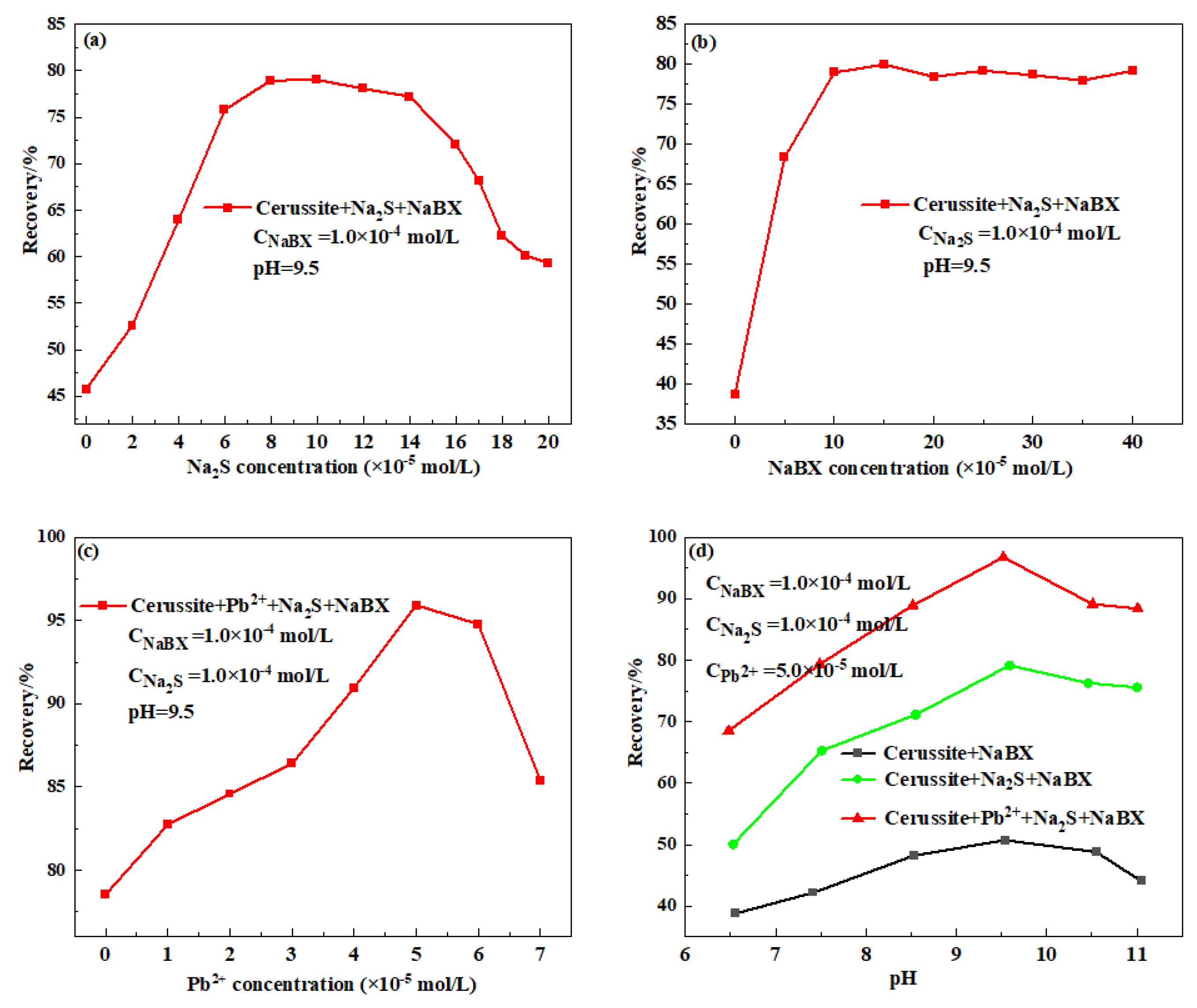

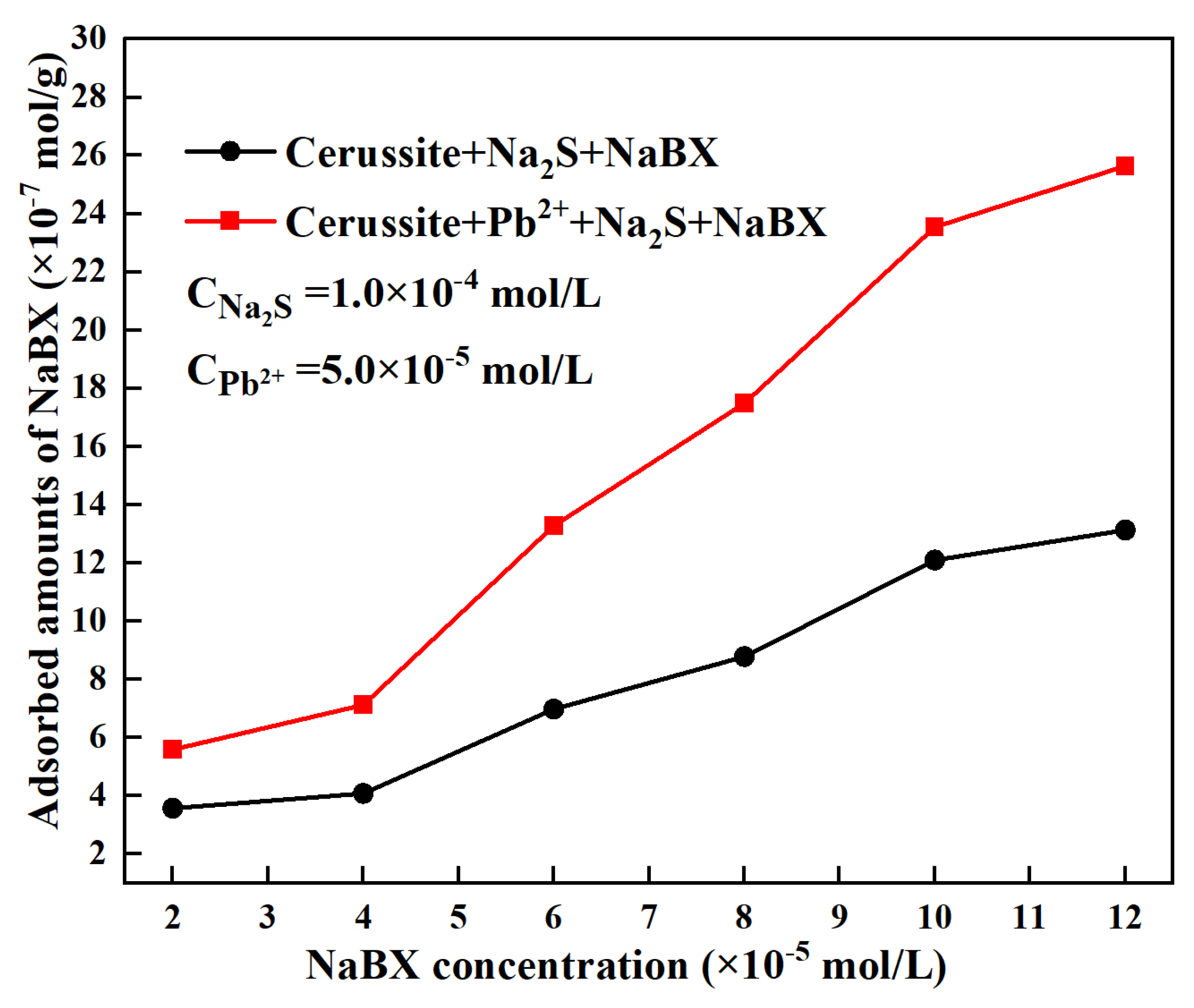
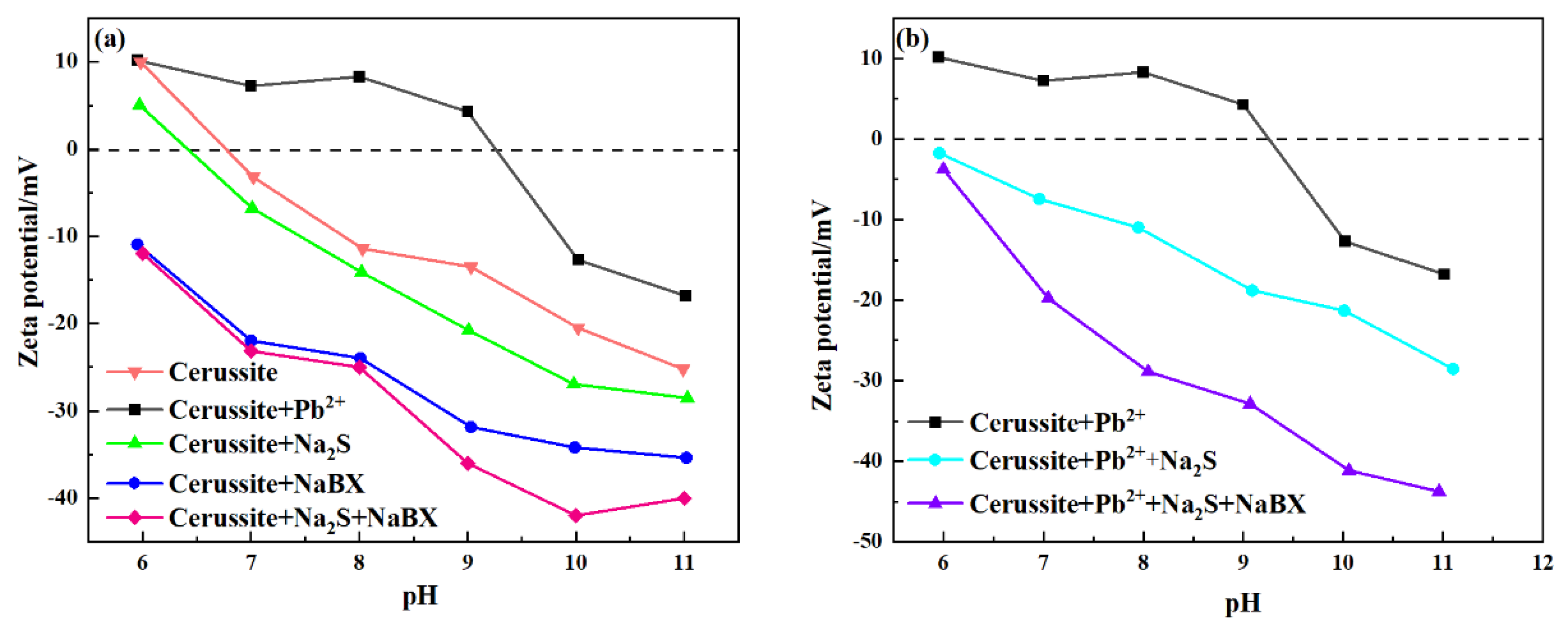
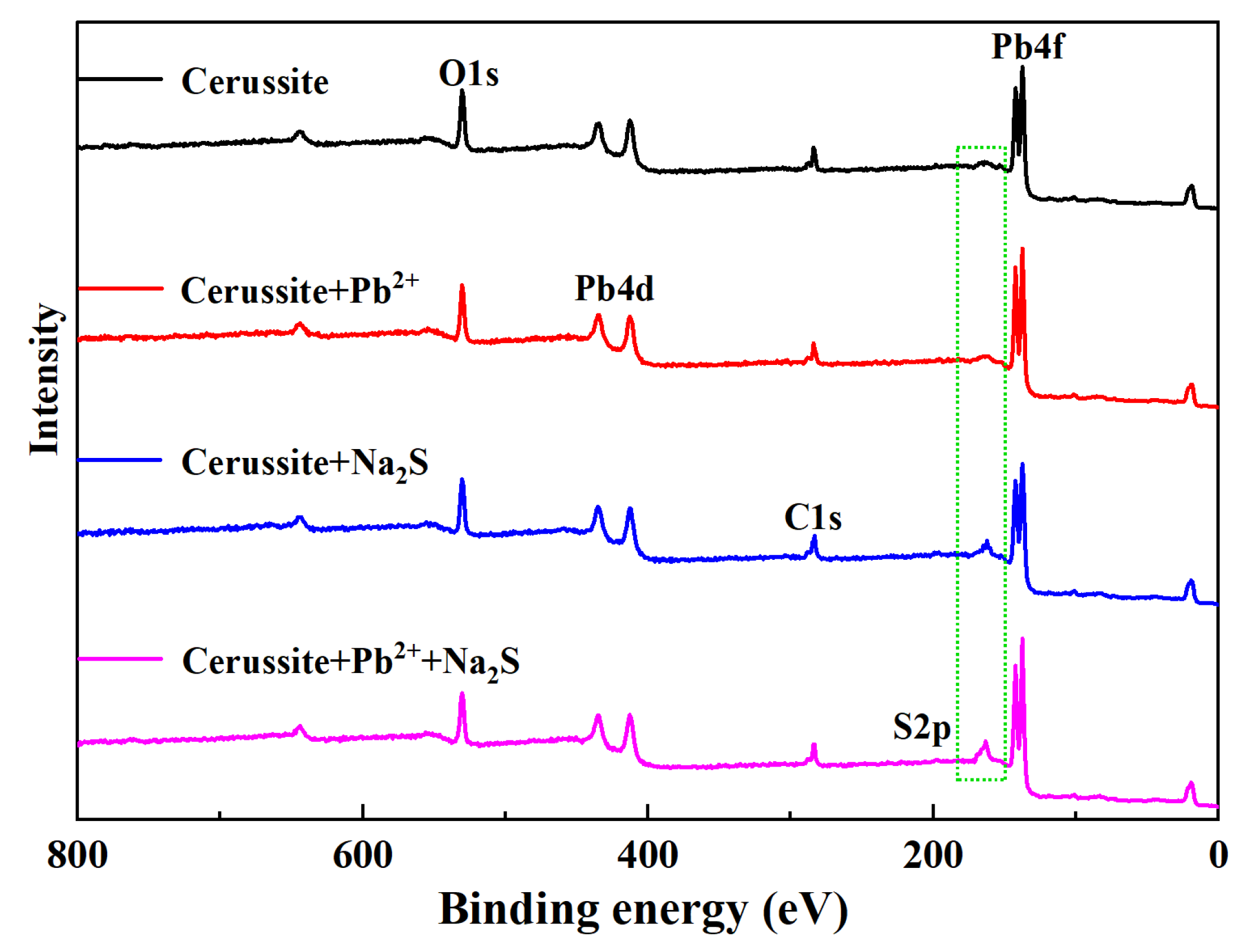
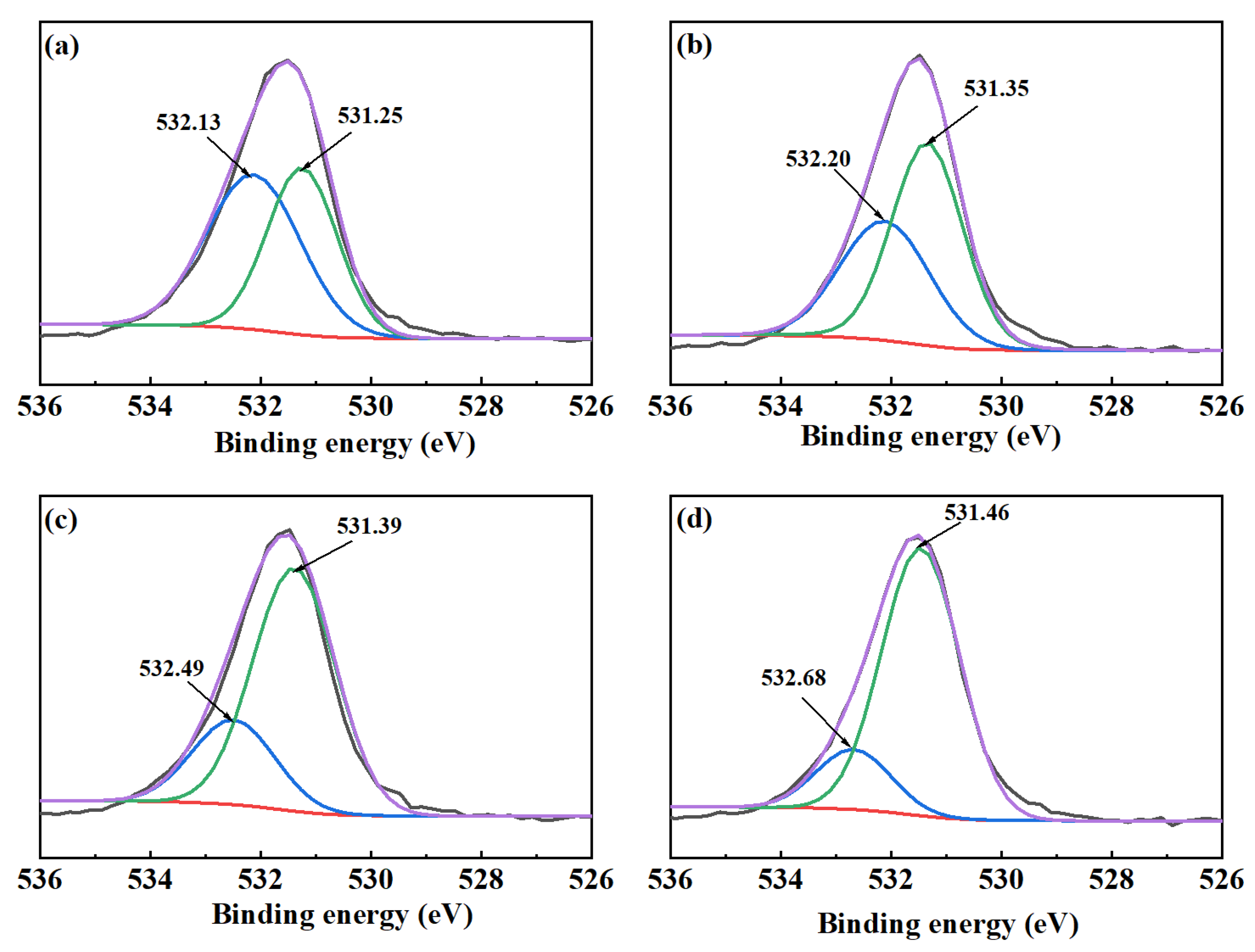
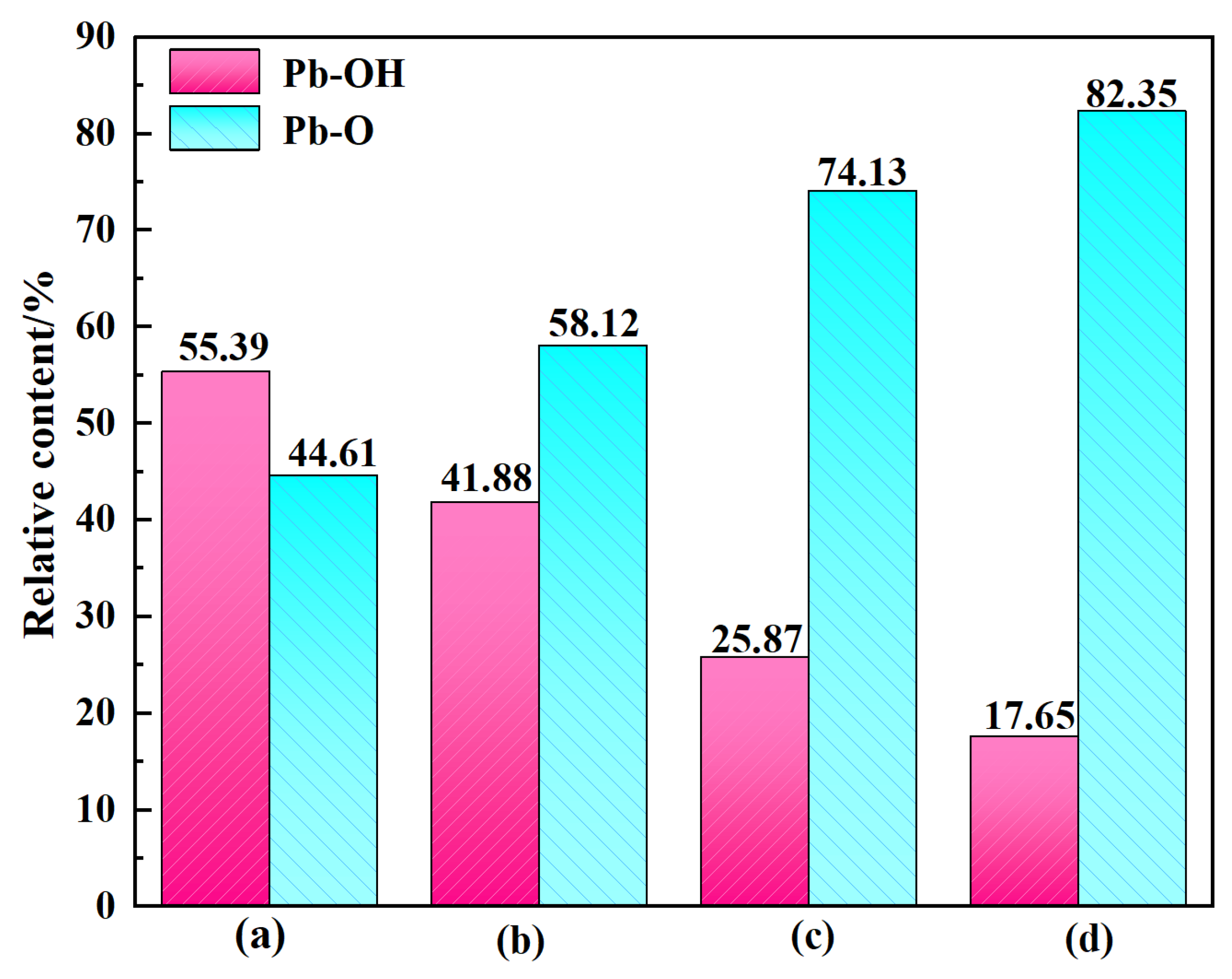

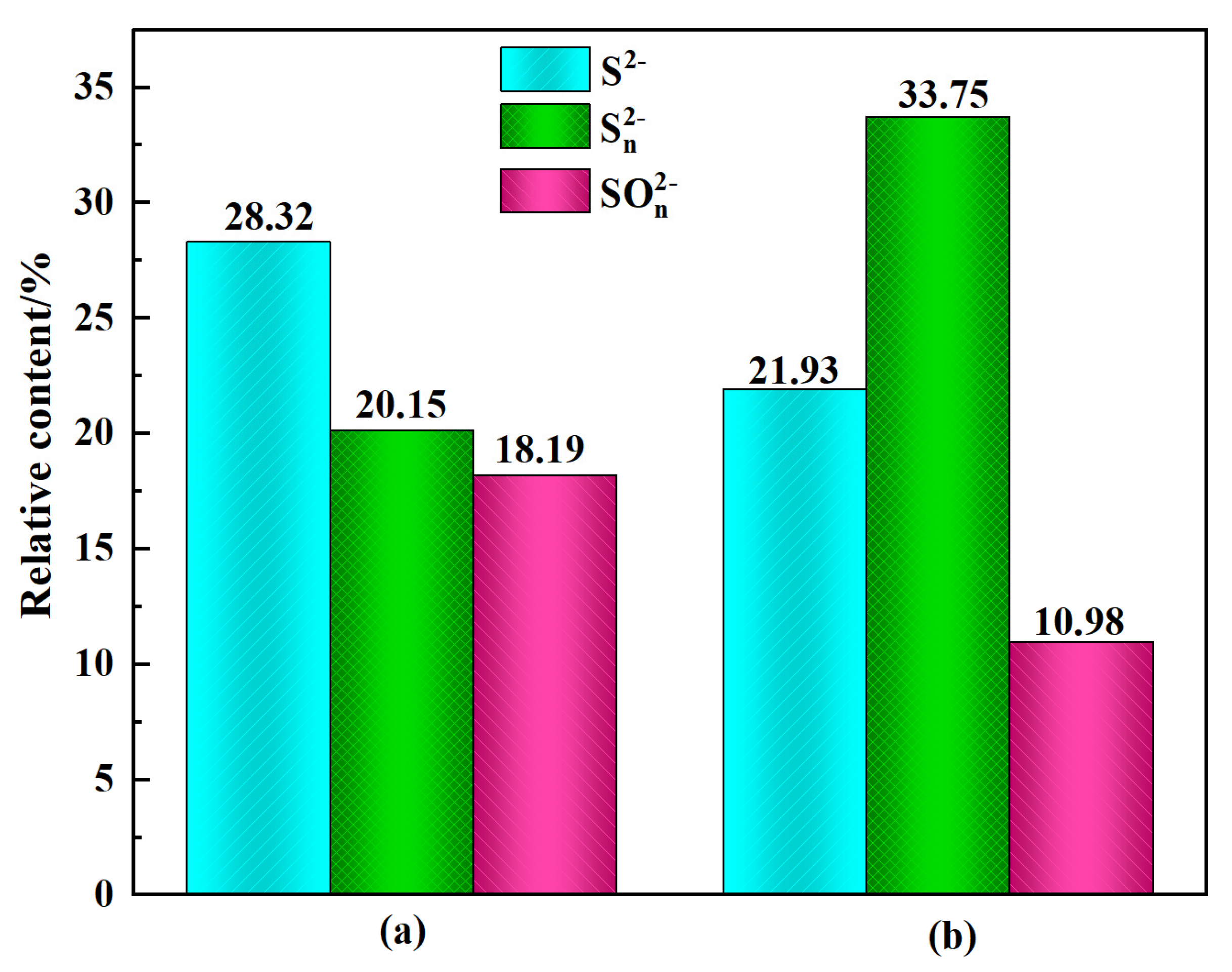
| Samples | Element (Mass%) | |||
|---|---|---|---|---|
| C1s | O1s | S2p | Pb4f | |
| cerussite | 15.72 | 64.27 | - | 20.01 |
| cerussite + Pb2+ | 16.18 | 57.68 | - | 26.14 |
| cerussite + Na2S | 10.73 | 53.98 | 16.52 | 18.77 |
| cerussite + Pb2+ + Na2S | 8.29 | 47.45 | 17.18 | 27.08 |
Disclaimer/Publisher’s Note: The statements, opinions and data contained in all publications are solely those of the individual author(s) and contributor(s) and not of MDPI and/or the editor(s). MDPI and/or the editor(s) disclaim responsibility for any injury to people or property resulting from any ideas, methods, instructions or products referred to in the content. |
© 2023 by the authors. Licensee MDPI, Basel, Switzerland. This article is an open access article distributed under the terms and conditions of the Creative Commons Attribution (CC BY) license (https://creativecommons.org/licenses/by/4.0/).
Share and Cite
Miao, Y.; Wen, S.; Shen, Z.; Zhang, Q.; Feng, Q. Enhancement of Xanthate Adsorption on Cerussite Surfaces by Pb(II) Activation and Its Effect on Floatability. Molecules 2023, 28, 2455. https://doi.org/10.3390/molecules28062455
Miao Y, Wen S, Shen Z, Zhang Q, Feng Q. Enhancement of Xanthate Adsorption on Cerussite Surfaces by Pb(II) Activation and Its Effect on Floatability. Molecules. 2023; 28(6):2455. https://doi.org/10.3390/molecules28062455
Chicago/Turabian StyleMiao, Yongchao, Shuming Wen, Zhihao Shen, Qian Zhang, and Qicheng Feng. 2023. "Enhancement of Xanthate Adsorption on Cerussite Surfaces by Pb(II) Activation and Its Effect on Floatability" Molecules 28, no. 6: 2455. https://doi.org/10.3390/molecules28062455
APA StyleMiao, Y., Wen, S., Shen, Z., Zhang, Q., & Feng, Q. (2023). Enhancement of Xanthate Adsorption on Cerussite Surfaces by Pb(II) Activation and Its Effect on Floatability. Molecules, 28(6), 2455. https://doi.org/10.3390/molecules28062455






